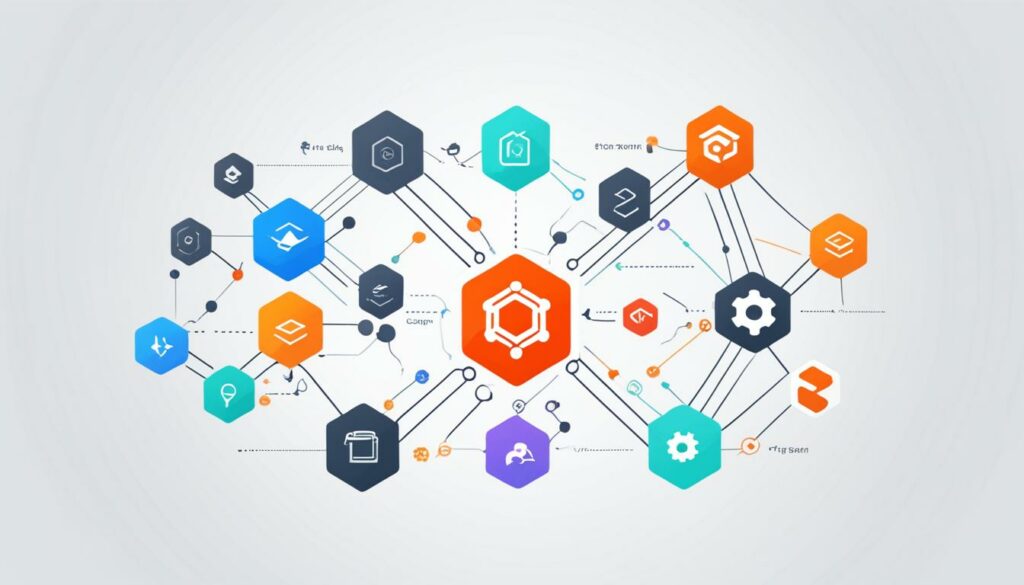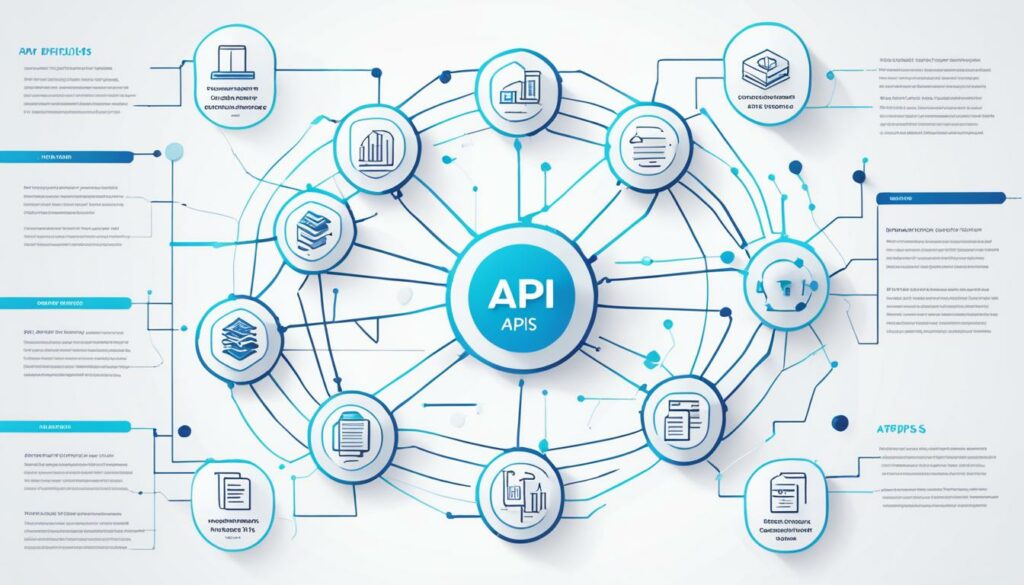An API integration is the connection between two or more applications, via their APIs, that lets those systems exchange data. API integrations power processes throughout many high-performing businesses that keep data in sync, enhance productivity, and drive revenue. An API, or “application programming interface,” is a set of subroutine definitions, protocols, and tools for building application software. APIs act as shipping vessels for software, allowing interactions or messages to be passed between applications. The most commonly-used API for web services is REST API, which offers flexibility, a gentler learning curve, and works directly from an HTTP URL. REST APIs involve parties like the web-based, API-enabled application, remote server, specific data request, and returned data/function. API integration refers to how two or more applications can be connected via their APIs to perform joint functions using the API layer. Building an API integration can be costly and time-consuming, but pre-built integration and automation tools can significantly reduce costs and save developer time.
Key Takeaways:
- An API integration connects two or more applications, enabling data exchange and enhancing business processes.
- APIs are the shipping vessels for software, allowing interactions between applications.
- REST API is the most commonly-used API for web services, offering flexibility and a gentle learning curve.
- API integration can be costly and time-consuming, but pre-built tools can reduce costs and save developer time.
- Pre-built tools are available to simplify API integration and automation processes.
Understanding APIs and API Integrations
APIs are like shipping vessels for software, allowing interactions or messages to be passed between applications. APIs act as a set of methods of communication between various software components.
Unlike user interfaces (UIs) that humans use to interact with software, APIs facilitate seamless communication between different software systems.
“APIs act as a set of methods of communication between various software components.”
In today’s digital landscape, APIs have gained immense popularity, with over 24,000 APIs currently in use.
The most commonly-used API for web services is REST API, which offers flexibility, a gentler learning curve, and works directly from an HTTP URL. REST APIs act as a standardized wrapper, enabling API-enabled applications to communicate with online servers and make information requests.
SOAP, another mature API developed in the 1990s, uses XML for message formats but may require an extensive XML framework to work with.
API Integrations Simplify Software Interactions
API integrations simplify software interactions by enabling applications to share data and functionalities seamlessly. By leveraging API integrations, businesses can enhance productivity, streamline operations, and drive revenue growth.
- APIs act as shipping vessels, facilitating interactions and messaging between applications.
- REST API is the most commonly-used API for web services due to its flexibility and gentle learning curve.
- SOAP is another mature API that uses XML for message formats.
Understanding APIs and API integrations is essential to harness the power of software connectivity and unlock opportunities for efficient and effective data exchange.
Benefits of API Integrations
API integrations offer a range of benefits that can significantly impact your business operations and overall efficiency. By implementing API integrations, you can streamline your operations, improve data accuracy, and enhance the security of your systems.
Streamline Operations: API integrations eliminate the need for manual data transfers between different systems. By automating the exchange of data, you can streamline your business processes, saving time and reducing the risk of errors.
Unified Customer View: API integrations provide a unified view of your customers. By integrating data from various sources and systems, you can create a comprehensive profile of each customer, allowing you to develop personalized strategies and improve customer engagement.
Real-Time Analytics: With API integrations, you can pull data from multiple sources in real-time. This enables you to access up-to-date information and perform real-time analytics, empowering you to make timely and informed decisions to drive your business forward.
Data Accuracy: API integrations ensure that all your systems are updated with the same data, eliminating discrepancies and inaccuracies. This data synchronization improves the accuracy of your operations and minimizes the risk of errors caused by outdated or inconsistent data.
Security: API integrations provide a layer of security with access controls. You can define and manage user permissions, ensuring that only authorized employees have access to specific data. This helps protect sensitive information, safeguarding your business and customer data.
To illustrate the benefits of API integrations, let’s take a look at the following data:
| Manual Data Transfer | API Integration | |
|---|---|---|
| Efficiency | Time-consuming | Streamlined process |
| Data Accuracy | Potential errors due to manual entry | Consistent and accurate data |
| Customer Engagement | Limited view of customer data | Comprehensive customer profile |
| Real-Time Analytics | Data lag and delays | Up-to-date and timely insights |
| Security | Increased risk of data breaches | Enhanced data protection |
As shown in the table, API integrations outperform manual data transfer methods across various factors, including efficiency, data accuracy, customer engagement, real-time analytics, and security.
API Integration Platform vs. In-House API Management
Choosing between an API integration platform and in-house API management is a crucial decision that can impact your company’s operations, scalability, and resource allocation. Let’s explore the advantages and considerations of each option.
API Integration Platform
An API integration platform is a third-party service that provides ready-to-use solutions for integrating different software systems. It offers scalability, handles the complexity of API integration, saves resources, and requires fewer upfront costs. By leveraging an API integration platform, you can:
- Easily connect and integrate various applications and systems
- Scale your integrations as your business grows
- Reduce the time and effort required for development and implementation
- Access a wide range of pre-built connectors and APIs
- Benefit from the platform’s ongoing maintenance and updates
Using an API integration platform allows you to focus on your core business activities while leaving the integration complexities to the experts. It provides a cost-effective solution with lower upfront costs compared to in-house API management.
In-House API Management
In-house API management involves developing and maintaining API integrations internally. While it offers customization and control, there are considerations to keep in mind:
- Scalability: Building scalable API integrations can be challenging, especially when your business needs grow.
- Complexity: Understanding and managing the intricacies of API integration can require specialized knowledge and expertise.
- Resource Allocation: Developing and maintaining API integrations internally requires dedicated resources, including developers and infrastructure
- Customization: In-house API management offers flexibility in tailoring the integrations to your specific needs.
- Maintenance: You’ll need to allocate resources for ongoing maintenance, updates, and bug fixes.
- Upfront Costs: In-house API management may involve higher upfront costs due to development and infrastructure investments.
While in-house API management provides control and customization, it requires significant investments in terms of time, resources, and expertise.
Ultimately, the choice between an API integration platform and in-house API management depends on your business requirements, budget, and available resources. Assess your scalability needs, the complexity of your integrations, and your customization requirements to make an informed decision.

Table: API Integration Platform vs. In-House API Management Comparison
| Considerations | API Integration Platform | In-House API Management |
|---|---|---|
| Scalability | Highly scalable, grows with your business | Challenging, requires dedicated resources |
| Complexity | Handles the complexity of API integration | Requires specialized knowledge and expertise |
| Resources | Uses platform’s resources, saves on infrastructure | Requires dedicated resources for development and maintenance |
| Customization | Offers customization options | Highly customizable to specific needs |
| Maintenance | Platform handles ongoing maintenance | Requires allocation of resources for maintenance and updates |
| Upfront Costs | Lower upfront costs | Higher upfront costs for development and infrastructure |
Improvado API Integration Platform

Improvado is a powerful marketing data pipeline solution, designed to simplify your marketing data operations. With its ease of use and shallow learning curve, Improvado provides an intuitive user interface that allows users to seamlessly integrate and manage their data.
One of the key strengths of Improvado is its flexibility and scalability. The platform supports over 500 data sources, giving you the freedom to connect with various systems and gather insights from multiple channels. Additionally, Improvado’s robust infrastructure can handle large volumes of data per request, ensuring efficient and reliable data processing.
When it comes to security and reliability, Improvado takes these aspects seriously. The platform complies with industry-standard security protocols, offering you peace of mind knowing that your data is protected. Furthermore, Improvado provides an explicit service-level agreement (SLA), guaranteeing the reliability and availability of the platform.
Integration capabilities are paramount for any API integration platform, and Improvado excels in this area. The platform seamlessly integrates with various existing systems, including data warehouses, analytics tools, BI platforms, and data visualization platforms. This enables you to centralize your data and gain comprehensive insights for better decision-making.
Improvado’s key features at a glance:
- User-friendly interface
- Pre-built API connectors
- Zero-code philosophy for ease of use
- Scalability to support over 500 data sources
- Robust security protocols
- Reliability with an explicit service-level agreement
- Integration capabilities with various existing systems
Improvado empowers businesses to streamline their data operations and harness the full potential of their marketing data.
Zapier API Integration Platform
Zapier is an API integration platform that excels in automating workflows between different web applications. With its user-friendly interface, drag-and-drop functionality, and vast library of pre-made Zaps, Zapier makes the integration process seamless and hassle-free.
One of the standout features of Zapier is its ease of use, which allows even non-technical users to create powerful integrations without the need for coding. The intuitive interface enables you to connect your favorite apps and automate repetitive tasks with just a few clicks.
When it comes to scalability, Zapier rises to the occasion. With support for over 5,000 apps, this platform can adapt to the evolving needs of your business. Whether you’re a small startup or a large enterprise, Zapier can handle your integration requirements with ease.
Security and reliability are top priorities for Zapier. All data transfers are encrypted using SSL/HTTPS, ensuring that your information is protected during transit. With Zapier’s robust infrastructure, you can rely on the platform to handle your integrations reliably and without downtime.
Zapier’s integration capabilities are expansive, allowing you to connect a wide range of existing systems. Whether you need to sync data between your CRM, marketing automation tools, project management software, or any other applications, Zapier has you covered. The platform acts as a bridge, facilitating seamless communication and data sharing across your entire software stack.
To illustrate, here’s an example of how Zapier can simplify your workflow:
You run an e-commerce store and want to automatically update your inventory in your CRM whenever a new order is placed. Using Zapier, you can create a Zap that connects your e-commerce platform to your CRM. Whenever a new order is received, Zapier triggers the integration, updating the inventory in your CRM in real-time. This process eliminates the need for manual data entry, reduces errors, and keeps your systems in sync.

Workato API Integration Platform
Workato is an enterprise automation platform that offers a comprehensive solution for API integration, automation, and API development. With its robust capabilities, Workato enables businesses to streamline processes, enhance efficiency, and drive productivity.
One of the key strengths of the Workato platform is its scalability. It seamlessly handles API integration across different cloud-based services, including CRM, marketing automation, and task management systems. Whether you’re connecting customer data or automating workflows, Workato empowers you to scale your operations and grow your business.
When it comes to security and reliability, Workato leaves no room for compromise. The platform adheres to industry-standard security protocols and complies with strict data protection regulations. You can trust that your sensitive information is protected and your integrations are secure.
With Workato’s extensive integration capabilities, you can create powerful workflows that automate tasks and connect various systems. From data synchronization to process orchestration, the platform empowers you to build robust integrations that drive efficiency and productivity.
Ready to experience the power of Workato? Sign up now and take your API integration to the next level!

| Features | Benefits |
|---|---|
| Scalability | – Handle API integration across multiple cloud-based services |
| Security | – Comply with industry-standard security protocols |
| Reliability | – Adhere to strict data protection regulations |
| Integration Capabilities | – Create powerful workflows that connect various systems |
Middleware Integration Tools for API Integrations
When it comes to connecting different software applications, middleware integration tools are essential. These tools act as a bridge between systems, enabling seamless data exchange and communication. When considering middleware integration tools for your API integrations, there are a few crucial factors to keep in mind.
Lightweight SMB Tools
For small and mid-sized businesses (SMBs), lightweight middleware integration tools are a great fit. These tools are designed with user-friendliness in mind, making them accessible to non-technical users. Lightweight SMB tools offer a simplified interface and intuitive design, allowing businesses to easily set up and manage API integrations without extensive technical knowledge or coding skills.
However, it’s important to note that lightweight SMB tools may have limitations when it comes to handling complex integrations. While they excel at basic integration tasks, they may lack advanced features and functionalities required for more intricate data workflows.
Heavy-Duty Enterprise Tools
On the other end of the spectrum, heavy-duty enterprise middleware integration tools cater to the needs of larger organizations with complex integration requirements. These tools offer a deeper suite of functionality, allowing for advanced data manipulation, transformation, and orchestration.
Heavy-duty enterprise tools provide granular control over data flows, enabling businesses to customize integration workflows to suit their exact needs. However, using these tools often requires coding skills and a dedicated technical team, which may not be feasible for all businesses.
Important Considerations
When evaluating middleware integration tools, it’s crucial to consider factors such as alerting capabilities, pricing models, data scalability, and connector scalability.
Alerting capabilities ensure that you receive timely notifications in case of any integration issues or errors. This allows you to address problems swiftly and minimize any potential downtime.
Pricing models vary across different middleware integration tools. Some tools offer subscription-based pricing, while others may charge based on usage or the number of connectors. It’s important to assess your budget and choose a pricing model that aligns with your financial goals.
Data scalability refers to the ability of the middleware integration tool to handle large volumes of data without compromising performance. Ensure that the tool can handle your current data needs and has room for future growth.
Connector scalability relates to the number of available connectors for integrating with various applications and data sources. The tool should have a wide range of connectors or the flexibility to develop custom connectors to seamlessly integrate with your existing systems.
By carefully considering these factors and understanding your business requirements, you can choose the right middleware integration tool that aligns with your needs and helps you achieve seamless API integrations.
Low-Code Automation Platforms for API Integrations
Low-code automation platforms provide an alternative to conventional middleware for seamless and customized API integrations. These platforms allow you to create workflows without coding knowledge, offering ease of use and a shallow learning curve. With low-code automation platforms, you can streamline the integration process and accelerate development time.
One of the key advantages of low-code automation platforms is their scalability. They can handle the increasing demands of enterprise-grade companies while also catering to the needs of mid-market businesses. Whether you’re a small startup or a large organization, these platforms can support your evolving needs.
Customization is another notable feature of low-code automation platforms. They offer a wide range of templates, pre-built connectors, and drag-and-drop functionality, allowing you to tailor your integrations to fit your specific requirements. This level of customization enables you to create unique workflows that align with your business processes.
When it comes to security, low-code automation platforms prioritize the protection of your data. They implement robust security measures and offer encryption protocols to ensure that your sensitive information remains safe throughout the integration process.
Integration capabilities are a crucial aspect of low-code automation platforms. They support various applications and databases, allowing you to connect different systems seamlessly. These platforms provide out-of-the-box integration options, as well as the flexibility to build custom integrations based on your specific needs. With their extensive integration capabilities, low-code automation platforms empower you to streamline your workflows and enhance data management.
The benefits of utilizing low-code automation platforms for API integrations are clear. They offer ease of use, scalability, customization, security, and extensive integration capabilities. By leveraging these platforms, you can accelerate your integration projects, improve efficiency, and achieve a more streamlined workflow.
Experience the power of low-code automation platforms for API integrations and revolutionize the way you connect and interact with your software systems.
| Benefits of Low-Code Automation Platforms for API Integrations |
|---|
| Ease of use |
| Scalability |
| Customization |
| Security |
| Integration capabilities |
Benefits of API Integrations for End Users
API integrations offer numerous benefits not only for businesses but also for end users. By automating tasks and eliminating manual data transfers, API integrations save you time and reduce the risk of errors. Instead of spending hours on mundane data entry, you can focus on more important and strategic tasks that would enhance your productivity and make your work more efficient.
API integrations provide access to more comprehensive and accurate data, allowing for better decision-making. With real-time data synchronization between different systems and applications, you can have a unified and up-to-date view of important information, helping you make informed choices without delays or outdated data.
The integration of APIs also enhances the user experience by enabling seamless and personalized interactions with various software systems. This means that you can access the functionality and data you need from different applications without switching between multiple interfaces or dealing with complex data transfers. This streamlined experience not only saves you time but also reduces frustration by providing a smooth and effortless workflow.
Overall, API integrations empower you to work smarter, not harder. By automating tasks, providing access to accurate data, and improving the user experience, API integrations simplify your work processes and enable you to achieve better results with less effort.
| Benefits of API Integrations for End Users: |
|---|
| Save time |
| Reduce errors |
| Improve productivity |
| Enhance user experience |
Now that you understand the benefits of API integrations for end users, you can see how these integrations can truly transform the way you work. By automating tasks, providing access to accurate data, and enhancing the user experience, API integrations enable you to be more productive and achieve better results. Whether you’re a manager, a developer, or a user, embracing API integrations can significantly improve your day-to-day work and contribute to the success of your organization.
Conclusion
API integrations are a crucial aspect of modern business operations. By seamlessly connecting software and services, API integrations enhance productivity, drive revenue, and improve the user experience. Whether you choose to leverage API integration platforms or manage integration in-house, you can streamline operations, achieve a unified customer view, and access real-time analytics.
API integrations offer scalability, flexibility, security, and reliability, allowing businesses to adapt and grow while ensuring data protection and accuracy. When choosing the right API integration solution, it’s essential to consider your company’s specific needs and available resources. Low-code automation platforms provide a customizable and user-friendly alternative to traditional middleware, empowering businesses to create seamless workflows without extensive coding knowledge.
In conclusion, API integrations bring numerous benefits to both businesses and end users. They save time, reduce errors, improve productivity, and enhance the overall user experience. Whether you’re a small startup or a large enterprise, leveraging API integrations can unlock new opportunities, optimize processes, and drive success in today’s interconnected digital landscape.
FAQ
Q: What is an API?
A: An API, or application programming interface, is a set of subroutine definitions, protocols, and tools for building application software. APIs act as shipping vessels for software, allowing interactions or messages to be passed between applications.
Q: How do APIs and API integrations work?
A: APIs act as a set of methods of communication between various software components. API integrations involve connecting two or more applications via their APIs to perform joint functions using the API layer.
Q: What is the most commonly-used API for web services?
A: The most commonly-used API for web services is REST API, which offers flexibility, a gentler learning curve, and works directly from an HTTP URL.
Q: What are the benefits of API integrations?
A: API integrations streamline operations, provide a unified customer view, offer real-time analytics, ensure data accuracy, and provide a security layer with access controls.
Q: Should I use an API integration platform or in-house API management?
A: Choosing between an API integration platform and in-house API management depends on factors such as scalability, complexity, resource allocation, customization, maintenance, and upfront costs.
Q: What is Improvado API Integration Platform?
A: Improvado is an end-to-end marketing data pipeline solution that simplifies marketing data operations, offering scalability, security, integration capabilities, and a user-friendly interface.
Q: What is Zapier API Integration Platform?
A: Zapier is an API integration platform that automates workflows between different web applications, offering scalability, security, integration capabilities, and a user-friendly interface.
Q: What is Workato API Integration Platform?
A: Workato is an enterprise automation platform that allows for API integration, offering scalability, security, integration capabilities, and automation features.
Q: What are middleware integration tools for API integrations?
A: Middleware integration tools connect different software applications, with lightweight SMB tools suitable for small and mid-sized businesses, and heavy-duty enterprise tools offering more functionality but requiring coding skills.
Q: What are low-code automation platforms for API integrations?
A: Low-code automation platforms provide a customizable and user-friendly alternative to conventional middleware, allowing users to create workflows without coding knowledge and offering scalability and integration capabilities.
Q: What are the benefits of API integrations for end users?
A: API integrations save time, reduce errors, improve productivity, and enhance the user experience by automating tasks, eliminating manual data transfers, and providing access to comprehensive and accurate data.
Q: How do API integrations improve business operations?
A: API integrations streamline operations, provide a unified view of the customer, offer real-time analytics, ensure data accuracy, and provide a security layer with access controls, improving efficiency, decision-making, and customer engagement.












